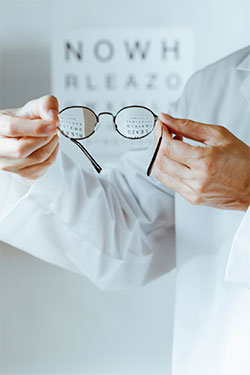
|
Traditionally, before eyewear was delivered to an awaiting client, it underwent an evaluation and correction procedure intended to make sure it complied with a concept called "bench alignment." There are five aspects that constitute good bench alignment for eyeglass frames:
1. Align the frame front to make it symmetrical flat or with slight faceform and parallel i.e., not propeller-ed.
2. Angle the temples so that the frame has a "four-point" symmetrical touch, first upside down and then right-side up positions.
3. Align temple closure for symmetry.
4. Where present, symmetrically-align nose pads.
5. Align temple "splay angle" for symmetry and parallelism.
Symmetry in nature possesses a powerful draw. Evolution has imparted a deep instinct within us to see symmetry as highly attractive and desirable. And since the craft of eyewear came from the highly refined hands of experienced jewelers and craftsmen, it is no wonder that obtaining symmetrical bench alignment for a frame has been considered an essential skill for eyecare professionals.
KABOOM – Enter Personalized Lenses
Today, with the explosion of personalized options available in digital, free form lenses, it may just be time for us to rethink the goal of seeking a symmetrical approach to frame alignment.
With the advent of an ECP's ability to enter tailored values for pantoscopic tilt, frame wrap and vertex distance, it is more important than ever to understand the importance of properly fitting the chosen frame to its purchaser before measurements are taken. Whether you choose manual measuring methods, or prefer one of the newer, state-of-the-art digital centration units, obtaining correct and representative values for position of wear is severely compromised without completing the actual frame fit to a client's face and head.
As Leonardo da Vinci discovered, the anatomy of the human head, ears, nose and face is rarely, if ever, symmetrical. While adhering to symmetrical bench alignment clearly works against the very idea of a personalized fitting, truly personalized and tailored measurements are vastly incomplete without inclusion of individual client fitting preferences, such as loose/tight, up/down the bridge, and cheek/eyebrow clearance and coverage. And add in a dash of reality in the form of the inescapable pull of gravity, and it's obvious that continuing to employ traditional bench alignment as an added value to ensure client satisfaction is about as useful as sticking a square peg in a round hole.
So, instead of fighting asymmetry, embrace it! Interview your client while fitting their selected style, and ask where they like their eyewear to sit and feel on their head and face. Keep a large mirror nearby and continue to ask them for feedback on balance, comfort and cosmetics. Often during this process, they'll shoot back "What do you think? You're the expert!" Tactfully explain that with frame fitting alignment and preferences, there are no absolute truths…only general guidelines.
To help illustrate this point, I'll like to use the analogy of preference in cooked meat: "Some people like it rare, some like it well, but both extremes of raw and charred are to be avoided. My goal is to understand how to obtain a frame fit just right for your taste." With the frame fitting accomplished, now take all your personalized measurements. Believe me, no doubt your client will be impressed! Be sure to note that the frame enclosed for the lab order has been "pre-fitted," and that its alignment should be left undisturbed as much as possible. This is easier to accomplish within an in-office finishing lab, and is a compelling reason to consider investing in quality edging equipment if haven't already done so.
The final coup des gras is when the client comes to try on their new (and expensive) eyewear for the first time. "How do they fit?" "Perfect!" is always the expected answer.











